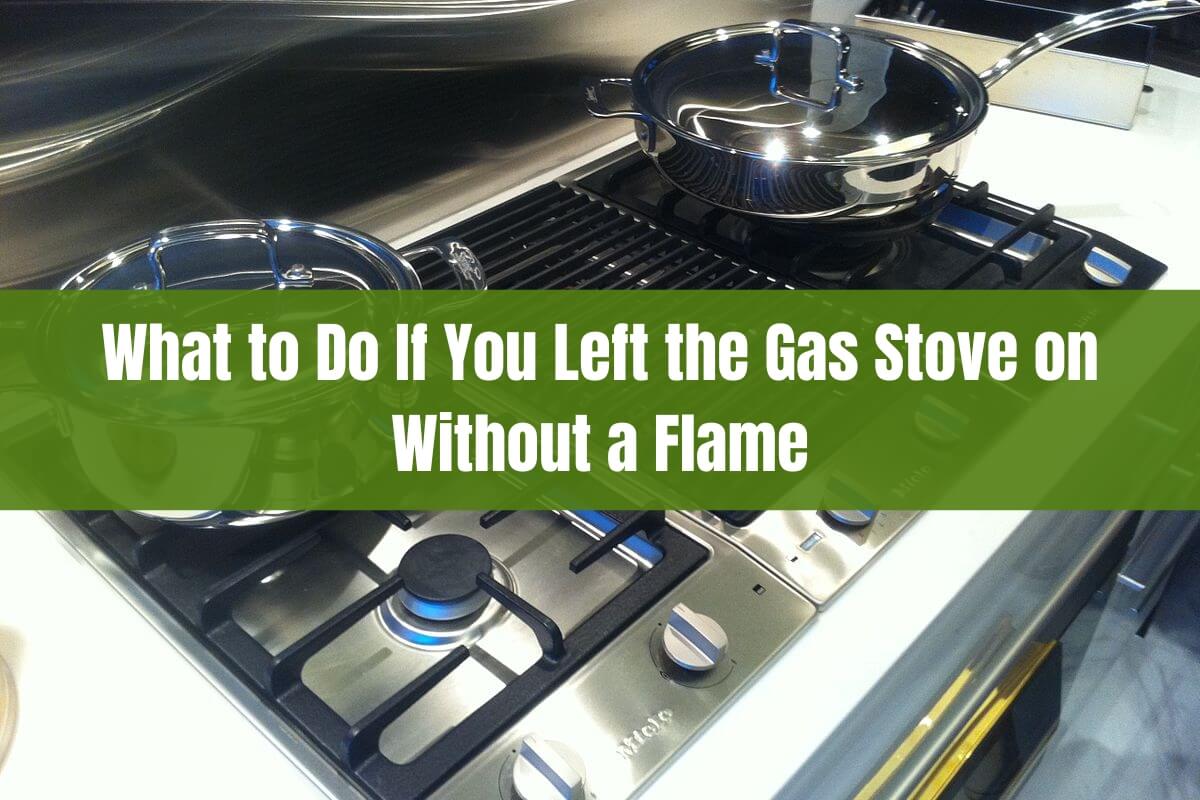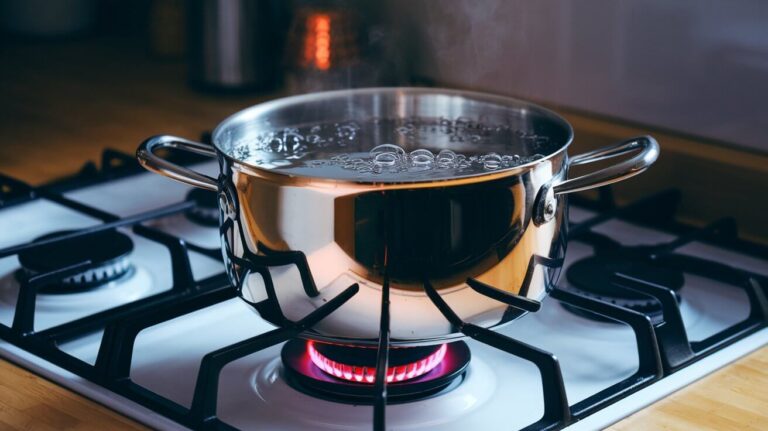
Have you ever walked into the kitchen and gotten a whiff of that distinct rotten egg smell, only to realize in horror that you left a gas stove burner on without a flame? It’s a terrifying moment that can happen to anyone. Leaving a gas stove unlit is incredibly dangerous and requires immediate action to prevent potential fires, explosions, or carbon monoxide poisoning.
But what exactly should you do if you find yourself in this scary situation?
The most crucial steps are to remain calm, evacuate the area, ventilate properly, avoid igniting any flames, and call emergency services if needed. This post covers the detailed steps to take, the risks involved, how to safely ventilate, when to seek medical help, preventative measures, and essential gas stove safety tips.
Immediate Steps to Take
If you realize you’ve left a gas stove burner on without a flame, the first priority is to act quickly but stay calm. Panicking can lead to rash decisions that may escalate the situation. Here are the steps to take immediately:
- Do not panic, and remain calm.
- Do not turn any lights or electrical switches on or off. This can create sparks that may ignite the gas.
- Do not use any electrical appliances or mobile phones near the area. Electrical devices can also produce sparks.
- Safely turn off the gas supply to the stove if possible. Locate the shutoff valve for the stove and turn it to the closed position. However, if the gas smell is already strong, it’s safer to evacuate first.
- Open windows and doors to ventilate the area. This will help dissipate the gas buildup.
- Evacuate the home immediately if the gas smell is strong. Leave through the nearest exit and go outside to fresh air.
- Do not attempt to reignite the stove or create any flames. This could cause an explosion if gas has built up.
- Call 911 or your gas company’s emergency line from outside. Let professionals assess and handle the situation.
Following these steps quickly can help prevent accidents and minimize the risks associated with gas leaks.
Risks of Leaving a Gas Stove Unlit
Leaving a gas stove on without a flame is extremely hazardous for several reasons:
- Potential gas buildup, creating a fire or explosion risk. Natural gas is highly flammable, and if enough gas accumulates in an enclosed space, even a small spark could ignite it.
- Release of carbon monoxide (CO), leading to potential CO poisoning. Unburned natural gas releases carbon monoxide, an odorless, colorless, toxic gas that can cause poisoning at high concentrations.
- Symptoms of gas leak exposure. Inhaling natural gas or carbon monoxide can cause headaches, nausea, dizziness, fatigue, eye irritation, skin blisters, and difficulty breathing.
The severity of these risks depends on factors like the size of the room, ventilation levels, and how long the stove was left on unlit. Even a short period can be dangerous in a poorly ventilated space.
How Long Does It Take for Natural Gas to Build Up to Dangerous Levels?
There’s no definitive timeframe for when natural gas levels become hazardous, as it depends on several variables. However, in a small, poorly ventilated room, gas can potentially reach explosive or toxic levels within 30 minutes of the stove being left on without a flame.
Larger, well-ventilated spaces may take longer for gas to accumulate to dangerous concentrations. But it’s never wise to leave a gas leak unattended, as the risks escalate quickly.
Steps for Proper Ventilation
Proper ventilation is crucial for clearing out any accumulated gas and making the area safe again. However, the steps must be followed carefully:
- Do not open windows immediately upon discovering the leak. Counterintuitively, this can initially feed more oxygen to the gas, increasing the explosion risk.
- Once you’ve evacuated to the outside, open all doors and windows. This allows for cross-ventilation to help dissipate the gas.
- Use fans or open vents to help circulate air, if available. Moving air helps flush out gas more quickly.
- Do not re-enter the home until firefighters or the gas company professionals have deemed it safe. They have specialized equipment to detect gas levels and will ventilate the area thoroughly.
Attempting to prematurely re-enter or restart gas appliances before the area is cleared could have devastating consequences.
When to Seek Medical Attention for Gas Exposure
If anyone in the household is experiencing symptoms like headaches, nausea, dizziness, or general malaise after the gas leak incident, it’s crucial to seek medical attention immediately. These could be signs of carbon monoxide poisoning.
Carbon monoxide is an extremely dangerous, potentially fatal gas that initially causes flu-like symptoms. At high levels, it can lead to unconsciousness, brain damage, or even death. Call 911 or head to the emergency room right away if severe symptoms are present.
Mild symptoms may subside after evacuating to fresh air, but it’s still advisable to get checked by a doctor as a precaution, especially for vulnerable groups like children, pregnant women, and the elderly.
Waiting to Reignite the Stove
Even after the area has been ventilated and deemed safe to re-enter by professionals, it’s crucial to wait before attempting to reignite the gas stove. Here are some key points:
- Let the house fully air out for at least 1-2 hours. Keep windows open and use fans to fully clear any residual gas.
- Do not reignite the stove before having a professional inspect for leaks. There may be an underlying issue that needs repair.
- Consider replacing older stove models that lack automatic shutoff features. This can prevent future incidents.
It’s better to be cautious and patient, as a small remaining gas concentration could lead to a dangerous situation if the stove is relit prematurely.
Preventing Future Gas Leaks
While dealing with a gas leak is scary, there are preventative measures you can take to improve safety and avoid future incidents:
- Install carbon monoxide detectors near gas appliances. These devices can alert you to dangerous CO levels before symptoms occur.
- Have gas lines and appliances professionally inspected annually. Maintenance helps identify potential leaks or issues before they become hazardous.
- Always double-check that burners are completely turned off after use. This simple habit can prevent accidental gas leaks.
- Consider replacing older stove models without automatic shutoff features. Many modern gas stoves will automatically cut off gas flow if no flame is detected, adding an extra layer of safety.
- Keep the area around the stove clear of flammable items. Loose clothing, oven mitts, paper towels, etc. could potentially ignite if too close to an unlit burner.
Gas Stove Safety Tips
In addition to the preventative steps above, here are some essential gas stove safety tips to follow:
- Use the exhaust vent or open windows while cooking. This helps ventilate any gas fumes or smoke.
- Never leave the stove unattended while in use. Unattended cooking is a leading cause of kitchen fires.
- Clean the stove and burners regularly. Built-up grime or food debris can clog burners, preventing proper ignition.
- Install safety knobs or valves if children or seniors are present. This makes it harder for the stove to be turned on accidentally.
- Be cautious when using electric or battery-powered appliances near gas stoves. Sparks from malfunctions could ignite gas fumes.
Following these simple precautions can significantly reduce the risks associated with gas stoves and promote a safer kitchen environment.
Is a Gas Leak Covered by Home Insurance?
If a gas leak does occur and causes damage to your home, most standard homeowner’s insurance policies will provide coverage. However, there are a few important points to note:
- Document everything related to the leak and damage. Take photos, videos, keep receipts for repairs, etc. This evidence will support your claim.
- File the claim promptly after the incident. Most policies require claims to be filed within a reasonable timeframe.
- Be prepared to show proof of regular appliance maintenance. Insurers may deny claims if negligence on maintenance contributed to the leak.
- Review your policy for specifics on gas leak coverage. Some limits or deductibles may apply based on your plan.
Working closely with your insurance provider can help ensure you receive the proper compensation for any damages caused by an accidental gas leak.
When to Replace Your Gas Stove
In some cases, a gas leak incident may reveal that it’s time to replace your aging gas stove entirely. Here are a few indicators it may be due for an upgrade:
- The stove is 15 years old or older. Older models tend to lack modern safety features like automatic gas shutoff valves. The risk increases as components wear down over time.
- You’ve repeatedly had issues with burners not igniting properly. Frequent ignition failures could signal an underlying problem that may lead to gas buildup.
- The stove is no longer functioning safely or efficiently. If the stove seems to be deteriorating and you have persistent concerns about its safe operation, it’s likely better to replace it.
Investing in a new gas stove with the latest safety technologies like automatic shutoff and gas sensors can give you greater peace of mind and help prevent hazardous leaks.
Is a Gas Leak an Emergency?
Absolutely – any uncontrolled gas leak should be treated as an emergency situation. Natural gas is extremely flammable and hazardous if allowed to accumulate.
Even if you don’t initially smell the distinct rotten egg odor that’s added to natural gas, you should still evacuate the area and call 911 or the gas company’s emergency line. They have specialized equipment to detect and mitigate gas leaks safely.
Don’t underestimate the dangers or try to handle a gas leak on your own. Leaving it unchecked could lead to fires, explosions, or carbon monoxide poisoning. Always err on the side of caution and let trained professionals assess and resolve the situation.
Conclusion
Accidentally leaving a gas stove on without a flame is undoubtedly a scary situation, but remaining calm and taking the proper steps is crucial for preventing worst-case scenarios.
The most important actions are immediately evacuating the area, not creating any sparks or flames, ventilating properly, and calling emergency services to handle the leak safely. Installing detectors, keeping up with maintenance, and being vigilant about turning off the stove can also help prevent these incidents.
While the situation may seem daunting in the moment, having an action plan and understanding the risks can give you the knowledge to respond appropriately and protect yourself and your loved ones. Stay safe, and don’t hesitate to get expert help when needed.






